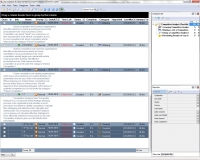|
Task Management Software |
 |
|
|
|
|
| |
|
 TESTIMONIALS TESTIMONIALS
|
|
"...This is an excellent program. I'm so glad that I stumbled on to this when researching for task management programs. Very low learning curv, quite flexible, and the price is right. Tried at least 20 other programs, either too complicated, too expensive, or poor documentation..."
Chad Lindsey -
Honolulu, HI
|
|
|
|
|
|
|
|
Competitive Analysis Checklist |
|
|
|
|
|
|

 |
Whatever the industry sector in which your organization exists there are competitors, and to succeed in the competitive environment you should know how to analyze your competitors and generate ways to leave them far behind. Use the following Competitive Analysis Checklist to know more.
|
| Order 750 checklists in MS Word and PDF printable format at $49.99 USD only. |
BUY NOW!  |
- Definition and Advantages.
- Competitive Analysis (aka "Competitor Analysis") is a component of the strategic planning process of an organization and includes a set of processes and tasks to identify competitors, evaluate their strategies and determine their strengths and weaknesses. By conducting analysis, your company can develop effective strategies to more efficiently market its own products or services. This gives you the listed below advantages.
- You can better understand competitive advantages/disadvantages of your company with relation to your competitors.
- You can generate a better understanding of competitors’ past, present and future strategies.
- Analysis process provides you with a basis for developing marketing strategies to achieve competitive advantages in the future.
- You can make more accurate forecasts concerning future investments of your company in a new product or pricing strategy.
- Making a List of Competitors.
- Identify your competitors. Start your competitor analysis with developing a list of your company's competitors. First, consider the range of competition in your market by classifying all existing businesses into Direct competitors, Indirect competitors and Future competitors, with relation to your business. Then develop the competitors list considering three categories "Direct Competitors", "Indirect Competitors" and "Future Competitors". It is recommended using software to make such a list.
- Direct competitors are business organizations that offer identical or similar products/services to the products/services of your business. Direct competitors can easily "steal" your customers, so they represent the most intense competition to you. In your competitors list, direct competitors will be listed under the category "Direct Competitors".
- Indirect competitors are business organizations that offer products/services which are close substitutes to your products/services. Such competitors usually target your market with similar value proposition but they sell different products/services. Add names of indirect competitors to your list under the category "Indirect Competitors."
- Future competitors are existing organizations which have not yet entered your market but they can potentially become your rivals in the nearest future. When entering your market, future competitors can turn into either direct or indirect rivals – this will depend on their marketing strategies. Add names of potential competitors to your list under the category "Future Competitors."
- Using a Competitor Analysis Grid.
- Define strengths and weaknesses of competitors. It is important to find out what makes your rivals successful or failed. Basically, by defining strengths and weaknesses of competitors, you can investigate your competitors’ assets, skills and competitive advantages that they bring into the marketplace to gain a competitive advantage. A competitor analysis grid as well as your competitors list will help you collect necessary information on your competitors, analyze it, and develop reports that can be used later in developing a marketing plan.
- The grid (or matrix) is a large table that allows comparing your business opponents considering a number of perspectives, including product/service info, customer info, and sources of competitive advantage. In the table, you should add a spreadsheet that lists criteria for identifying differences and similarities. Your criteria for analyzing business opponents may include such indicators as the sales volume, the customer satisfaction level, the time on the market, and others. It is recommended using Annual Reports, Securities Firms Reports, Government Reports and Internet Resources to fill in the cells of your example.
- Annual reports. If your rivals are publicly-listed business organizations, most likely they release annual reports that are available at their corporate websites. You can easily visit such websites to learn more on their current positions on the market.
- Securities firms reports. Usually every respectable securities company conducts marketing research in various industrial sectors to collect, compile and analyze business data. Such companies issue reports in which you can probably find valued information about your rivals and your industry.
- Government reports. Government agencies (like The Security and Exchange Commission, Department of Commerce, and Federal Trade Commission in the USA) usually collect, maintain, and update information about business companies. You can visit official government websites to review and download formal documents and reports.
- Internet resources. The web-space and search engines (like Google and MNS) give you lots of online sources of information where you can find media articles, product reviews, and other valued business information that give insight into your competitors.
- Reviewing Results of Your Analysis.
- Go to your matrix and write up the most important information on your competitors. You should not describe the whole analysis you’ve made in your grid, but only summarize it, list the top 5 direct competitors to your business, and outline the most effective tools that let your business successfully compete on the market.
- Make a short yet comprehensive report in which you provide some insight for the reader about current situation on the market, your direct and indirect competitors, market tendencies, and future changes. For example, if your matrix shows that on the market there are few competitors, then you can summarize that you have found a niche market, or your marketing campaign has been successfully organized.
- Look for opportunities. Review your competitor analysis table to reveal the strengths and weaknesses of your competitors. Then look for the opportunities that your company can potentially use to gain more advantages. In your outline report, you can list what opportunities you company can take. Then you can use this information in developing your marketing plan.
- Develop competitive strategies. Usually a traditional approach to the development of competitive strategies involves using the following information: Cost leadership, Product differentiation, Innovation, Growth, Alliance, and Time. You can use your matrix to extract such information.
- Lessons Learned. It is important to keep the history of your activities in a safe place, so you can get any information on your competitors easily and quickly after some time goes by. Therefore, save your table in a file and use it any time when you need to develop your own marketing plan.
| Order 750 checklists in MS Word and PDF printable format at $49.99 USD only. |
BUY NOW!  |
|





 |
CentriQS Tasks Management Solution 
Looking for multi-user task management software? Try CentriQS complete task management solution for planning, tracking and reporting tasks, projects, and schedules. Increase productivity of your small business or office by better organizing your employees' tasks and time.
 FREE Download CentriQS FREE Download CentriQS
|
|
|
|
|
|
|
|
|
|
CentriQS  -15% OFF -15% OFF |
All-in-one business management software
for small and midsize enterprises |
 |
|
|
| VIP Task Manager |
Multi-user project management software
to plan, schedule and track project tasks. |
 |
|
|
| VIP Checklists
|
More than 750 ready-to-use to-do lists
to plan your personal and business life |
 |
|
|
| VIP Team To Do List |
Professional task management software
to make and send team todo lists by email |
 |
|
|
| VIP Organizer |
Personal time management software
to organize time at home and at work |
 |
|
|
| VIP Simple To Do List
|
Simple and effective to-do list software
to plan daily chores, trips, wedding, etc. |
 |
|
|
|
|
|
|
|